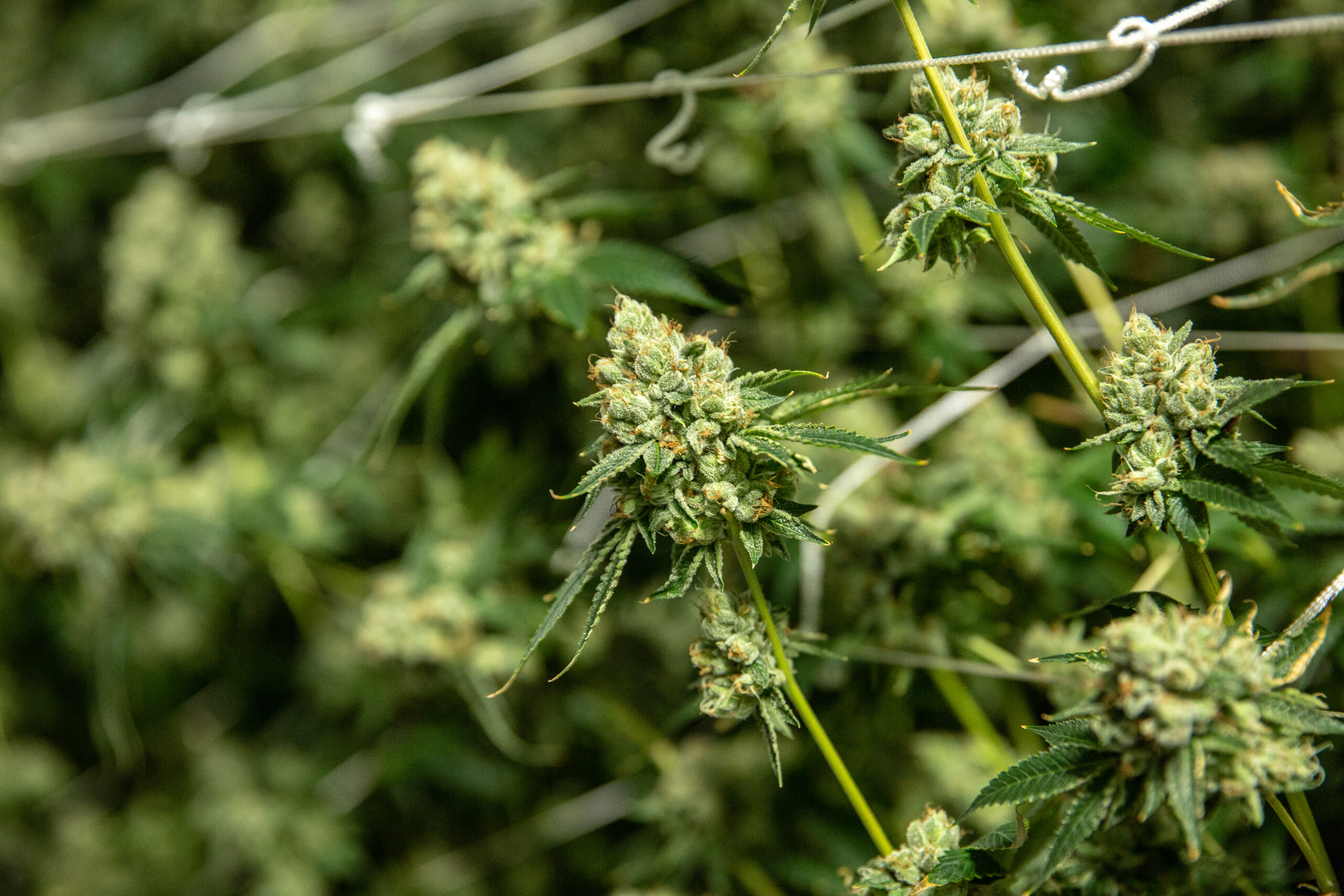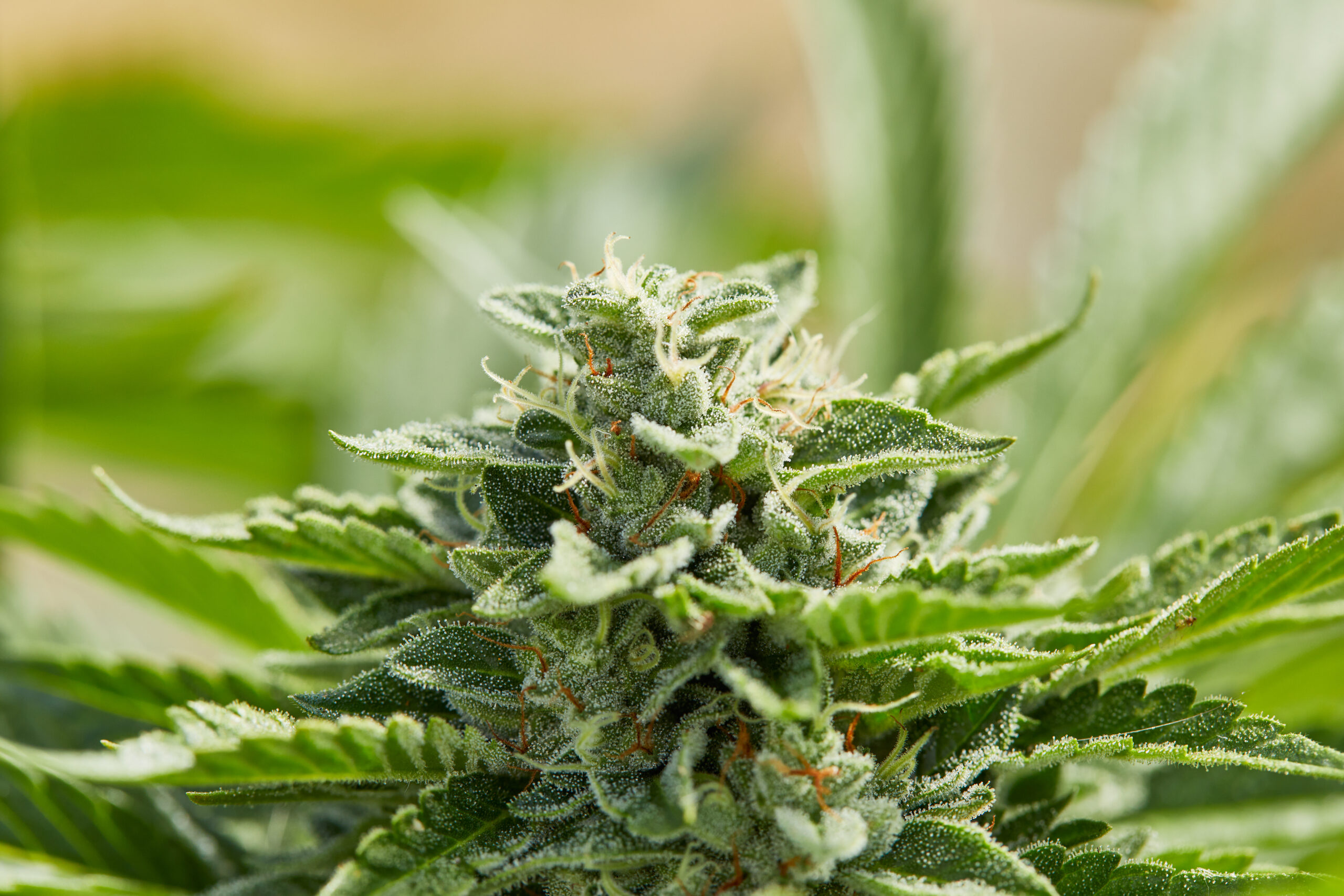Whether you're a Master Grower or a home gardener, one of the most important considerations for cannabis cultivators is the growing medium used to support plant development, growth, and nourishment. Luckily, growers have lots of options when it comes to their crops. Learn about all manner of earthy foundations, from basic soil types to what makes soil better (or worse) for cannabis to making your own weed-friendly soil.
Why soil quality matters
Cannabis sativa L. is a hardy plant family that's been successful in different climates and conditions, from balmy tropical locales with fertile grounds to relatively cold and harsher climates with less hospitable land. But while cannabis can succeed in different soil conditions, dialing in various qualities of your soil to be more weed-friendly can better support your plants and drastically benefit the yield and final quality of your buds.
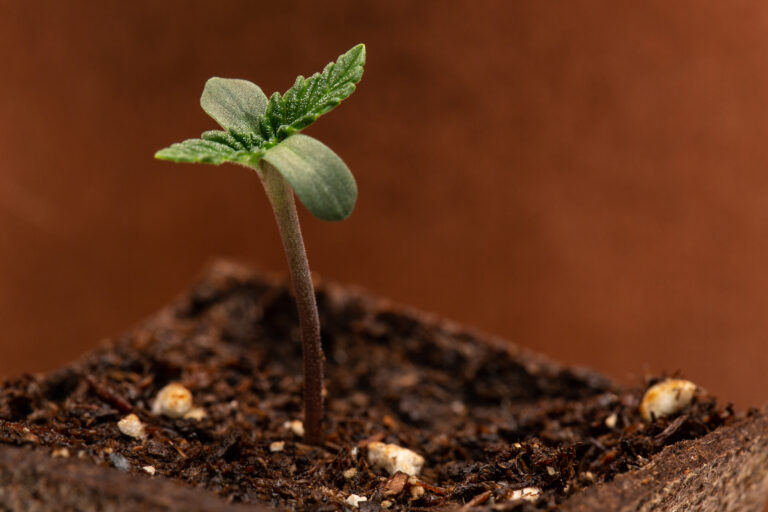 Photo by: Gina Coleman/Weedmaps
Photo by: Gina Coleman/WeedmapsImage lightbox

There are the so-called “soilless" options, such as hydroponics, aeroponics, or coco coir, all of which have distinct pros and cons. But for many cannabis growers, nothing beats plain soil. It's the OG growing medium, after all. And while soil is a great medium that offers many advantages, not all soil is created equal.
“The importance of soil quality when growing cannabis cannot be overstated," said Tina Ho of Good Plant Care. “High-quality soil provides an optimal environment for root growth, nutrient uptake, and overall plant health."
Varieties of natural soil
The quality and composition of natural soil — that is, soil that you'll find in the ground — varies widely depending on where you are. When it comes to home gardening, there are typically four main types of soil you'll find outdoors:
Sandy
Sandy soil is light, airy, and easy to work with. It has a coarse texture that facilitates water drainage, but has poor water and nutrient retention. As a result, sandy soils dry out quickly and nutrients are easily washed away by rain or watering. Sandy soils may also be quite acidic.
- Easy to work — light and coarse
- Good drainage
- Poor water and nutrient retention
- Can be acidic (low pH)
Silty
Silty soils bring in decent water drainage and good water retention. They also offer minerals and other organic substances that can help nourish plants. The major drawback of silt-rich soils is that they can be prone to compaction, which can reduce and even severely impact a plant's access to the air, water, and nutrients within it.
- Easy to work — medium-coarse
- Good water retention
- Fair water drainage
- Contains nutrients and organic materials to help nourish plants
- Prone to compaction
Clay
Clay soils are heavier and denser than sandy or silty soils. It can easily clump and become compacted, which can make clay-heavy soils difficult to work with. Clay soils hang on to water, which is good for retention but leads to poor drainage. They're often among the most fertile of soils, holding a variety of nutrients and minerals.
- Hard to work — heavy and dense
- Good water retention
- Poor water drainage
- Contains nutrients and minerals to help nourish plants
- Prone to compaction
Loamy
Loamy soils are a mixture of sand, silt, and clay. They can contain varying proportions of each, but generally avoid the extremes of any of its components and offer more balance. Loamy soils are airy, easy to work, offer good water retention and drainage, and also contain minerals and nutrients that are beneficial for plants.
- Easy to work
- Combination of sand, silt, and clay soils
- Good water retention and drainage
- Contains nutrients and minerals to help nourish plants
- Natural soils often need amending to become loams
Which soil traits are most important for growing cannabis?
Different cannabis cultivars (or strains) may have different preferences when it comes to nutrients, water or pH levels, and other idiosyncrasies, and these are all impacted by various traits in soil.
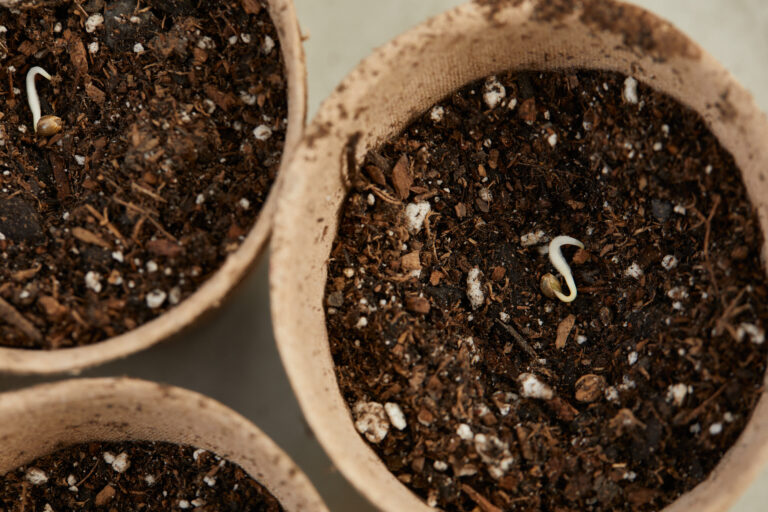 Photo by: Gina Coleman/Weedmaps
Photo by: Gina Coleman/WeedmapsImage lightbox

Experienced growers may be able to dial in very specific soil traits or variables to optimize the growth of a specific cultivar or even for a specific growing environment. But, generally speaking, there are four high level soil traits that are important for cannabis plants.
Texture
Soil texture varies and is indicative of the proportions of sand, silt, and clay in the soil. Soil that is predominantly sand, for example, will have a very light texture, whereas soil that is predominantly clay will have a more dense and heavy texture.
Cannabis plants generally prefer a lighter texture. “A light, loose, and airy texture promotes proper root growth and nutrient absorption," explained Ho.
Water drainage
How quickly and easily water drains from the soil is another important factor to consider. “The soil needs to drain well because cannabis doesn't like 'wet feet' [roots]," said Ed Geis, hemp farmer and owner of Bald Mountain Botanicals.
Good drainage is important for keeping the root zone properly oxygenated. Prolonged exposure to water-saturated soil can damage the root system, impact plant growth, and cause root rot. “A 'sandy loam' is ideal in the field. For growing in containers, you want something that drains well but also absorbs and retains some moisture so the soil stays damp after watering, but not saturated," shared Geis.
Water retention
The flip side of drainage is retention. While good drainage is important for cannabis, so is water retention. Optimal soil will have the right balance between the two.
Acidity
The pH value of soil indicates how acidic or alkaline it is, and it's a very important soil variable since it impacts the plant's ability to absorb nutrients. In fact, different minerals and other nutrients have particular pH ranges in which they are optimally absorbed. Cannabis normally thrives in slightly acidic soil. The general pH range that is optimal for cannabis is between 5.8 and 6.5, but when needed, you can adjust the pH of your soil with specialized liquid solutions designed to increase or decrease pH.
Nutrients
Proper nutrients are essential for cannabis plant growth, development, and general health. “Cannabis plants require a balanced mix of macronutrients (nitrogen, phosphorus, and potassium) and micronutrients (calcium, magnesium, and sulfur) for optimal growth," explained Ho.
When growing in the soil, there are two main ways to get your plant nutrients: purchase or create a nutrient-rich soil in which nutrients are made available to the plant as needed, or begin with a relatively neutral soil and provide nutrients yourself, typically by adding them to the water each time you water your plants.
How to improve soil texture, drainage, and water retention
There are a variety of ways you can change or “amend" soil to better suit the cannabis plant's needs. Some store-bought soils, particularly those made for cannabis, may already have these amendments added, so check the ingredients list of soils when purchasing.
- Coco coir: Coco coir is a coconut-derived fiber made from husks. While it can be used as a growing medium all on its own, it can also be added to soil to make its texture lighter while improving water retention.
- Perlite: Perlite is a natural volcanic glass that has a granular texture and white or gray color. When added to soil, it helps improve aeration and drainage.
- Vermiculite: A naturally occurring mineral that is often used to lighten up soil texture and increase moisture retention.
- Clay pebbles: When growing in containers, these pebbles can be added to the bottom of pots to assist with drainage and prevent pooled water to help avoid excess root moisture. They can also be used on topsoil as a form of mulch.
- Worm castings: The waste material from worms can do double duty in helping to improve texture, drainage, and retention of the soil while also being a rich source of both micro and macronutrients.
While this list is not exhaustive, these common soil amendments used by cannabis gardeners can improve texture, drainage, and water retention.
4 best soils for growing cannabis
When you want a ready-to-use bag of cannabis-friendly soil, here are four options that cover indoor, outdoor, container, and in-ground growing.
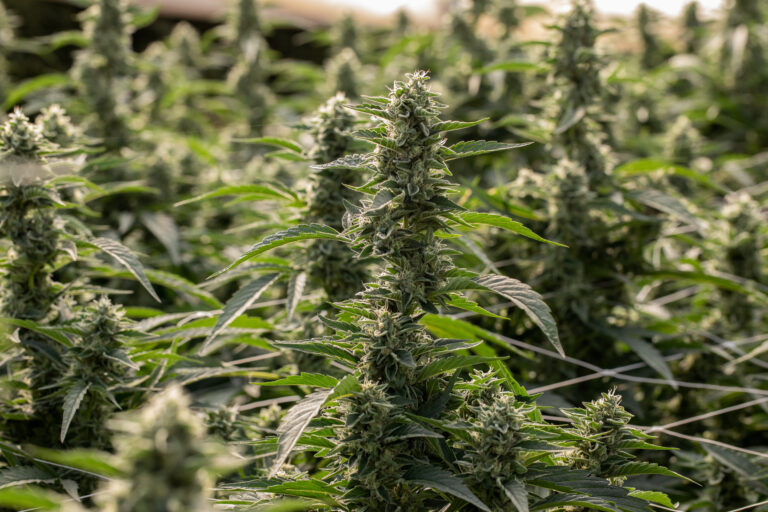 Photo by: Gina Coleman/Weedmaps
Photo by: Gina Coleman/WeedmapsImage lightbox

Best potting soil: Fox Farm Happy Frog Potting Soil
Anything labeled as a “potting" product has been developed with container growing in mind. Potting soils and potting mixes are typically light and airy mixtures with good drainage and water retention. Regular or “garden soils" are too heavy and prone to compaction for the relatively small space of a container.
The names “potting soil" and “potting mix" are often used interchangeably, but they can be quite different. Potting soil may or may not contain soil (aka actual dirt), whereas potting mix is often a completely soilless medium made up of ingredients such as peat moss, perlite, and vermiculite. Potting soils may or may not contain natural ingredients for plant nutrients or slow-release chemical fertilizers.
Happy Frog Potting Soil is a very popular choice for container cannabis gardeners that doubles as a live soil option: It's enriched with earthworm castings, bat guano, and aged forest products. In addition to the Happy Frog potting soil, many of Fox Farm's growing mediums are popular among cannabis growers and available nationwide.
- Pros: Ideal for container growing
- Cons: More expensive than other potting soils or mixes
- Indoor or outdoor: Indoors or outdoors
- Notable features: Unique mix of beneficial soil microbes, mycorrhizal fungi, and sediment that increases root development
- Price: $35.88 / 2 cubic feet on Amazon
Always read product labels to know exactly what you're getting in potting soil. There are many all-purpose potting soils out there that can be amended and customized for cannabis alongside pre-made potting products specifically for cannabis plants.
Best living soil: Purple Cow Organics IndiCanja Organic Living Soil
Living soil is soil that cultivates and utilizes a living microbial network to feed plants. Often the go-to choice for organic growers, the microbial network in living soil responds to, and in turn is fed by, sugars and carbon the plant releases through its root system to provide the plant with nutrients as needed. It's a symbiotic relationship that has naturally evolved in all plants over millennia.
Living soil is also often called “super soil," but that term may refer to a specific recipe for cannabis soil from the breeder SubCool. In both cases, these labels refer to soils that intentionally build microbial communities to provide plants with the nutrients they need. “Personally, I believe the best flower is grown organically in living soil — a rich medium that contains lots of active microorganisms," said Geis. “Instead of feeding the plant conventional fertilizers, you 'feed the soil' with organic fertilizers — such as alfalfa meal — and the microorganisms break those materials down into forms that the plant can use."
Purple Cow offers a cannabis-specific living soil that was developed over several years by a Maine-based cannabis farmer. The IndiCanja Organic Living Soil is a water-only super soil containing everything needed to take your plant from seedling to harvest.
- Pros: All-natural and organic
- Cons: Living soils are among the most expensive soil options
- Indoor or outdoor: Indoors or outdoors
- Notable features: Water-only from seedling to harvest, third-party testing for heavy metals
- Price: $38.99 / cubic foot on Amazon
Purple Cow is one of those rare companies that conducts and shares the results of heavy metal testing for all its products.
Best organic soil: Coast of Maine Organic Raised Bed Castine Blend
Like living soil, organic soil contains natural plant and/or animal ingredients. But while living soil is typically organic, not all organic soils are living. Organic soils may be processed, heated, or otherwise sterilized to kill off any unwanted pests or pathogens, which also kills off beneficial microbial life. Organic soils should not contain substances such as chemical salts or synthetic fertilizers.
Coast of Maine's Castine Blend for outdoor raised bed gardening contains fully cured compost, sphagnum peat moss, dehydrated poultry manure, lobster and crab shell meal, greensand, biochar, worm castings, and mycorrhizae. It's also certified organic by the Organic Materials Review Institute (OMRI).
- Pros: Free of synthetic ingredients, certified organic
- Cons: Specific to raised beds
- Indoor or outdoor: Outdoors
- Notable features: Carefully formulated to provide a balance between structure, water retention, drainage, and aeration
- Price: $25.36 / cubic foot on Amazon
The use of an “organic" label on soil is not regulated and may mean different things for different products, so read ingredient lists to understand what's in the product. Some producers even supply third-party lab tests for contaminants such as heavy metals.
Best garden soil: Coast of Maine Cobscook Blend Garden Soil
Garden soil is made for in-ground use. It's often used as an amendment to improve the quality of the natural soils present in your garden and typically contains a blend of topsoil and other organic matter to lighten up texture and improve water retention. It may also contain compost or other fertilizers. Again, ingredients can vary widely, so check labels.
Coast of Maine's Cobscook Blend contains ingredients that were formulated to improve the structure, water retention, drainage, and aeration of your natural soil, with added compost for nutrients.
- Pros: Improves quality of existing ground soil
- Cons: Cannot be used for containers without proper amendments
- Indoor or outdoor: Outdoor
- Notable features: Made for in-ground use, enriched with compost
- Price: $27.70 / cubic foot on Amazon
How to make your own weed-friendly potting soil
Thanks to the ingenuity and experimentation of growers, there are lots of cannabis soil recipes to try. Some popular recipes include Coots Mix, a simple starter recipe that can be built upon, or SubCool's widely referenced and robust Super Soil recipe.
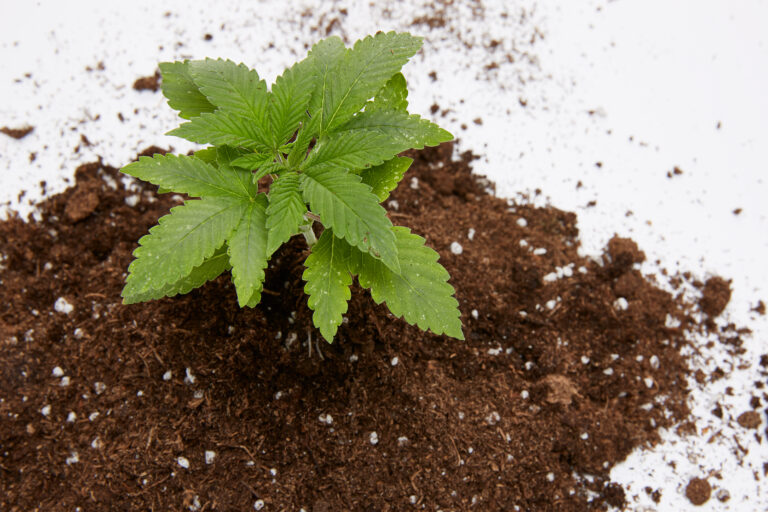 Photo by: Gina Coleman/Weedmaps
Photo by: Gina Coleman/WeedmapsImage lightbox

Cannabis soil blends can be highly customized to both the grower's and the cultivar's preferences, and with time and experience you can create your very own blend. Here is a simple recipe to get you started.
Yield: 10 gallons of potting mix
Ingredients
- 2 1/2 gallons garden soil
- 2 1/2 gallons peat moss or coco coir
- 2 1/2 gallons perlite or vermiculite
- 2 1/2 gallons compost, worm castings, or aged manure
Equipment
- Rubber gloves
- Container — large plastic tub or garbage can
- Spade
Step 1
Add a layer of about half your garden soil to the bottom of the container
Step 2
Cover with a layer of about half of your peat moss or coco coir
Step 3
Repeat with a layer of about half of your vermiculite
Step 4
Add a final layer of about half your compost, castings, or manure
Step 5
Repeat steps 1 - 4 with the remainder of your ingredients
Step 6
Using your hands and the spade, mix thoroughly until you have a nice uniform potting mix — it should take some sweat and effort to blend everything evenly
Tips
- When using living soil, it will require some lead time before it's ready for use. The newly assembled microbes need time to break down organic matter so that nutrients can become available to the plants. Ho explained, “Best to [mix your soil] several weeks or even months before starting the grow to allow it to 'cook' a bit so it doesn't burn sensitive plant roots."
- If you're using your own in-ground soil, consider testing it before you begin growing or adding amendments. You can get DIY soil tests at local nurseries or garden centers or make use of your local county extension office, which can run more accurate tests and provide information on your soil's texture — proportions of sand, silt, and clay — and pH levels.
FAQ
Can you plant cannabis in any soil?
Cannabis plants do best in soils with a light and airy texture with good water retention and drainage.
What is the pH for good cannabis soil?
Cannabis prefers slightly acidic soil. It can tolerate a fairly wide pH range, between 5.0 - 7.0, but most growers pin the optimal range for most cultivars between 5.8 and 6.5 pH.
What type of soil do autoflowers need?
Autoflower plants can thrive in the same types of soil as photoperiod plants, with adjustments made to account for its shorter all-around lifespan. “They may prefer a slightly lighter soil mix with lower nutrient levels, as they have a shorter vegetative stage and can be sensitive to over-fertilization," said Ho.
What are the best nutrients for weed in soil?
Regardless of the growing medium, cannabis plants need appropriate levels of essential macronutrients, including nitrogen, phosphorus, and potassium. They also need essential micronutrients such as magnesium, calcium, sulfur, boron, chlorine, copper, iron, manganese, molybdenum, and zinc to thrive.
How much and how often you need to feed plants with additional nutrients, fertilizers, or organic amendments will depend on the soil you begin with, but going overboard with nutrients can negatively affect your plant's health. A plant's nutrient needs will also change throughout its life cycle.
How much soil do you need per plant?
When growing in containers, the amount of soil needed per plant will depend on the size of the container(s) you're growing in. Container size is often chosen based on the location of the grow and the growing method. You may also choose to re-pot your plants into larger containers as they grow, which will require additional soil.
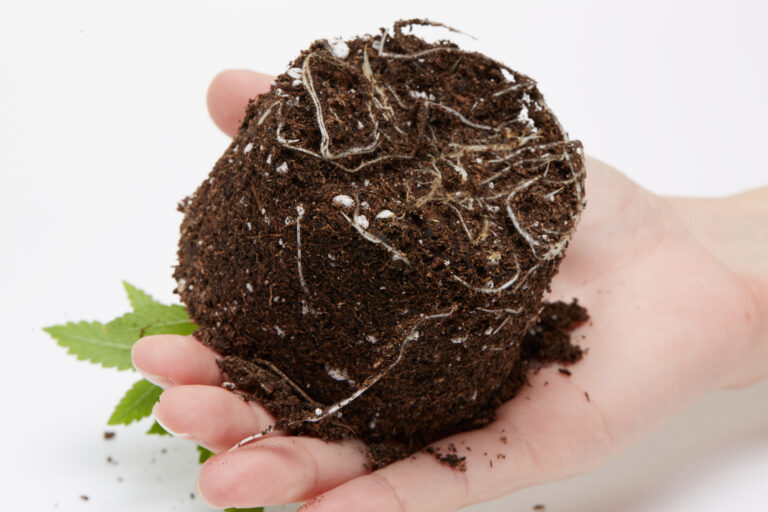 Photo by: Gina Coleman/Weedmaps
Photo by: Gina Coleman/WeedmapsImage lightbox

For example, in a small indoor space using the Sea of Green method, you may elect for smaller containers in and around three gallons, while outdoor grows may have the space to accommodate larger pots that can range up to seven gallons or larger. To estimate your soil needs, choose container sizes based on your grow environment and the final size of the plant.
Bottom line
Ensuring you have a quality soil that will adequately support and nourish your plants is the foundation of any successful grow. Whether experimenting with your own custom soil mixes or purchasing pre-made cannabis-specific products, your cannabis plants will thrive in a slightly acidic soil that is light and airy, while offering a good balance between water drainage and retention.
Written by Lauren Wilson | Featured image by Gina Coleman


